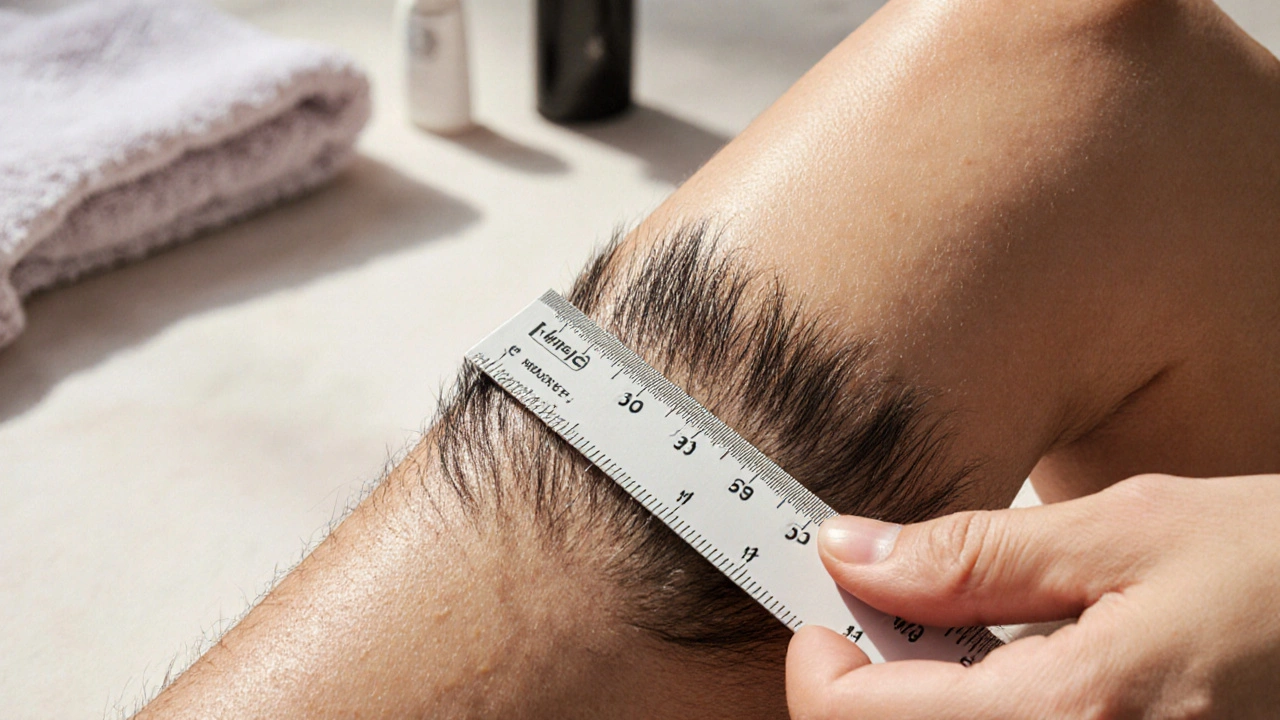Ever booked a waxing appointment only to realize your hair is still too short? You’re not alone. Most people think waxing is just about showing up and letting someone pull hair out - but the real secret is timing. If your hair is too short, the wax won’t grip. Too long, and it’s painful and messy. So how long does it actually take to grow hair before you can wax?
Minimum Hair Length for Effective Waxing
You need at least 1/4 inch of hair for wax to work properly. That’s about the length of a grain of rice. Anything shorter, and the wax just slides off without grabbing anything. This isn’t a guess - it’s what every professional esthetician uses as a baseline. Salons won’t even start if your hair is under this length. They’ll tell you to come back in a week.
On average, hair grows about 1/8 inch per week. That means if you’ve just shaved or haven’t let anything grow in a while, you’re looking at roughly two to four weeks of no shaving or trimming. Some people grow faster - up to 1/6 inch per week - but waiting four weeks is the safest bet, especially for sensitive areas like the bikini line or underarms.
Why Not Just Wait a Few Days?
Some folks think, “I’ll just skip shaving for three days and go.” That rarely works. Three days of growth might only get you to 1/16 inch - barely visible. Wax needs enough surface area to cling to. Without that, you’re left with patchy results, broken hairs, and irritation. Broken hairs grow back faster and feel prickly. You’ll end up waxing again sooner than you planned.
Think of it like trying to pick up a tiny pebble with tweezers versus a big rock. The bigger the hair, the easier it is to pull out cleanly. That’s why waxing works better than shaving - it removes the hair from the root. But only if it’s long enough to grab.
Body Area Matters
Not all body parts grow hair at the same speed. Your legs grow faster than your eyebrows. Your upper lip grows slower than your underarms. So timing varies by area.
- Legs and arms: Usually ready in 2-3 weeks. Hair here grows fast and thick.
- Bikini line and underarms: Best at 3-4 weeks. These areas are sensitive, so you want enough hair to reduce pain and ensure full removal.
- Face (upper lip, chin): Takes 3-4 weeks. Facial hair grows slower and is finer, so patience is key.
- Brows: 2-3 weeks. You don’t need much, but you still need enough to shape properly.
People who wax their brows often say they wait until they can see the hairs clearly - not just feel them. If you can’t see them in good lighting, they’re probably too short.
What Happens If You Wax Too Early?
Waxing hair that’s too short doesn’t just waste your time - it can damage your skin. Here’s what happens:
- Pain without results: The wax pulls on skin instead of hair, causing redness, swelling, and even small tears.
- Broken hairs: Short hairs snap off under the skin. These become ingrown hairs - itchy, bumpy, and sometimes infected.
- More frequent waxing: You’ll need to go back sooner because the hair grows back unevenly.
- Wasted money: Most salons charge the same whether they get results or not.
One client in Asheville told me she kept waxing every two weeks because she didn’t know the rule. After six months, she had a patchy bikini line full of ingrowns. She finally waited four weeks - and the difference was night and day. No bumps, no pain, and her skin stayed smooth for five weeks.
What Happens If You Wait Too Long?
There’s a sweet spot, but you can go too far. Hair longer than 1/2 inch starts to get tricky.
- More pain: Longer hairs have more leverage. When pulled, they tug harder on the follicle.
- Harder to remove: Thick, long hairs can tangle in the wax, making it harder to pull cleanly.
- Residue left behind: Salons often have to trim before waxing if hair is too long - which adds time and cost.
Some people wait six weeks because they’re afraid of the pain. But that doesn’t make it easier. In fact, longer hair often means more discomfort and a higher chance of skin irritation.
How to Track Your Growth
You don’t need a ruler. Here’s a simple trick: wait until you can see the hair clearly in natural light. If you can’t see it, it’s too short. If you can see it but it’s still fine and wispy, you’re close. When it looks like tiny dark specks - that’s your 1/4 inch mark.
Another way: after your last wax or shave, mark your calendar. Set a reminder for 3 weeks. Then, check the area. If it’s still too short, wait another 3-5 days. Most people find their perfect window after 2-3 tries.
Keep a little notebook - even just on your phone. Note the date you last waxed, how long you waited, and how your skin felt afterward. After a few cycles, you’ll know exactly how long your body needs.
What About Hair Growth Products?
There are tons of serums, oils, and supplements claiming to speed up hair growth for waxing. Most don’t work. Hair growth is mostly genetic and hormonal. No cream is going to turn a 1/8 inch growth rate into 1/4 inch in a week.
That said, keeping your skin healthy helps. Dry skin makes waxing harder. Moisturizing daily - especially with something gentle like aloe vera or jojoba oil - keeps the skin flexible and reduces redness. Avoid heavy lotions right before waxing, though. They can create a barrier that stops the wax from sticking.
Some people swear by castor oil applied a few nights before waxing. It doesn’t make hair grow faster, but it can soften the follicles, making removal easier. It’s not magic - just a little prep.

Seasonal Changes Affect Growth Too
Did you know your hair grows faster in summer? Warmer weather increases blood flow to the skin, which can boost growth by 10-15%. That’s why people in places like Asheville often find their hair grows quicker from May to September.
In winter, growth slows down. You might need an extra few days between sessions. Don’t panic if your usual 3-week cycle suddenly feels like 4. It’s normal.
What to Do If You’re Running Out of Time
You’ve got an event next weekend, and your hair is barely visible. What now?
- Don’t shave. Shaving resets the clock and makes everything worse.
- Trim only if necessary. If hair is over 1/2 inch, trim it down to 3/8 inch. Use small scissors. Don’t cut it too short.
- Go to a pro. Some salons have techniques for short hair - like hard wax or multiple passes. Ask ahead.
- Consider sugaring. It’s gentler on short hair than traditional wax. Some people find it works on hair as short as 1/8 inch.
There’s no shortcut. But with a little patience, you’ll get smoother skin that lasts longer - and fewer painful surprises.
Final Rule: Wait 3-4 Weeks, Always
Here’s the simplest advice: if you’re unsure, wait four weeks. It’s the universal sweet spot for most body areas. Four weeks means:
- Enough hair to grip
- Less pain than shorter sessions
- Longer smoothness - often 4 to 6 weeks
- Fewer ingrowns
- More consistent results
Once you hit that rhythm, you’ll wonder why you ever rushed it. Your skin will thank you.
Can I wax if my hair is only 1/8 inch long?
It’s possible, but not ideal. Some hard waxes can grip hair at 1/8 inch, especially on thicker hair like legs or underarms. But for most people, especially on sensitive areas like the bikini line or face, 1/4 inch is the minimum for clean, effective removal. Waxing at 1/8 inch often leads to broken hairs and irritation.
How soon after waxing can I shave?
You shouldn’t shave after waxing. Shaving cuts the hair at the surface, which defeats the purpose of waxing and can cause ingrown hairs. If you need to tidy up between sessions, wait until the hair grows back to 1/4 inch and wax again. Shaving resets your progress and makes future waxing harder.
Does waxing make hair grow back thinner over time?
Yes, over time. Waxing removes hair from the root, and repeated removal can weaken the follicle. After several months or years of regular waxing, many people notice hair grows back finer, sparser, and slower. It doesn’t disappear completely, but it becomes much easier to manage.
Is there a difference between hard wax and soft wax for short hair?
Yes. Hard wax is designed for sensitive areas and can grip shorter, finer hairs better than soft wax. It adheres to the hair without sticking as much to the skin, making it ideal for bikini lines and facial hair. Soft wax is better for larger areas like legs when hair is at least 1/4 inch. If your hair is borderline, ask your esthetician to use hard wax.
Why does my hair grow back so fast after waxing?
Hair grows back at different rates based on genetics, hormones, and body area. It’s not that waxing makes hair grow faster - it’s that you’re removing it from the root, so you notice it sooner. Shaving hides hair growth because it cuts it bluntly at the skin. Waxing reveals the natural growth cycle. Most people see regrowth around 3-4 weeks, which is normal.







Pamela Tanner
November 18, 2025 AT 05:39For anyone new to waxing, this is the most thorough guide I’ve ever read. Seriously, the 1/4 inch rule is non-negotiable-I learned the hard way after a disastrous bikini wax at 1/8 inch. Now I mark my calendar like it’s a dentist appointment. No more guessing.
Kristina Kalolo
November 18, 2025 AT 19:12Interesting breakdown on growth rates by area. I never realized facial hair grows slower than underarms. I’ve been waxing my upper lip every two weeks and wonder why it never looks clean. Time to adjust.
ravi kumar
November 20, 2025 AT 03:08As someone who’s been waxing for over a decade, I can confirm: four weeks is the magic number. Don’t rush it. Even if you’re in a hurry, waiting pays off in less pain and longer smoothness. Your skin will thank you later.
Megan Blakeman
November 21, 2025 AT 21:51I love this so much!!! I used to shave my legs every three days, then tried waxing and cried because it hurt so much… turns out I was only waiting two weeks?? Now I wait four, use aloe vera the night before, and my skin is like butter?? I feel like a new person. Thank you for this. 🙏
Akhil Bellam
November 22, 2025 AT 19:39How is this even a topic? If you can’t wait four weeks for a clean wax, you’re not ready for the discipline required to maintain smooth skin. Most people treat waxing like a quick fix, not a ritual. And don’t even get me started on sugaring-those amateurs think it’s a loophole. It’s not. It’s just slower, cheaper, and still ineffective on sub-1/4 inch hair. Real beauty requires patience, not shortcuts.
Amber Swartz
November 22, 2025 AT 22:13OMG I JUST HAD A WAXING DISASTER AND NOW I’M CRYING IN THE BATHROOM. I WENT AT 10 DAYS BECAUSE I HAD A WEDDING. NOW I HAVE INGROWNS EVERYWHERE AND MY SKIN LOOKS LIKE A MAP OF APOCALYPSE. I’M NEVER DOING THIS AGAIN. WHOEVER WROTE THIS-YOU’RE A GOD. I’M SAVING THIS.
Robert Byrne
November 23, 2025 AT 07:44Let me correct something: you said ‘shaving resets the clock.’ That’s misleading. Shaving doesn’t reset growth-it just cuts the hair. But yes, it makes waxing harder because it creates blunt ends that grow back prickly. And no, you shouldn’t shave between waxes. Ever. If you’re tempted, you’re not ready for waxing. Period.
Tia Muzdalifah
November 24, 2025 AT 12:34so like… i just waxed my legs and they’re already kinda fuzzy again? i thought it was supposed to last longer?? maybe i’m just bad at this lol
Zoe Hill
November 25, 2025 AT 05:48This was so helpful!! I’ve been waxing for years but never tracked my growth-just guessed. I’m gonna start a little note on my phone now. And yes, the castor oil tip? I’m trying it tonight. Thank you for making this feel less intimidating 😊